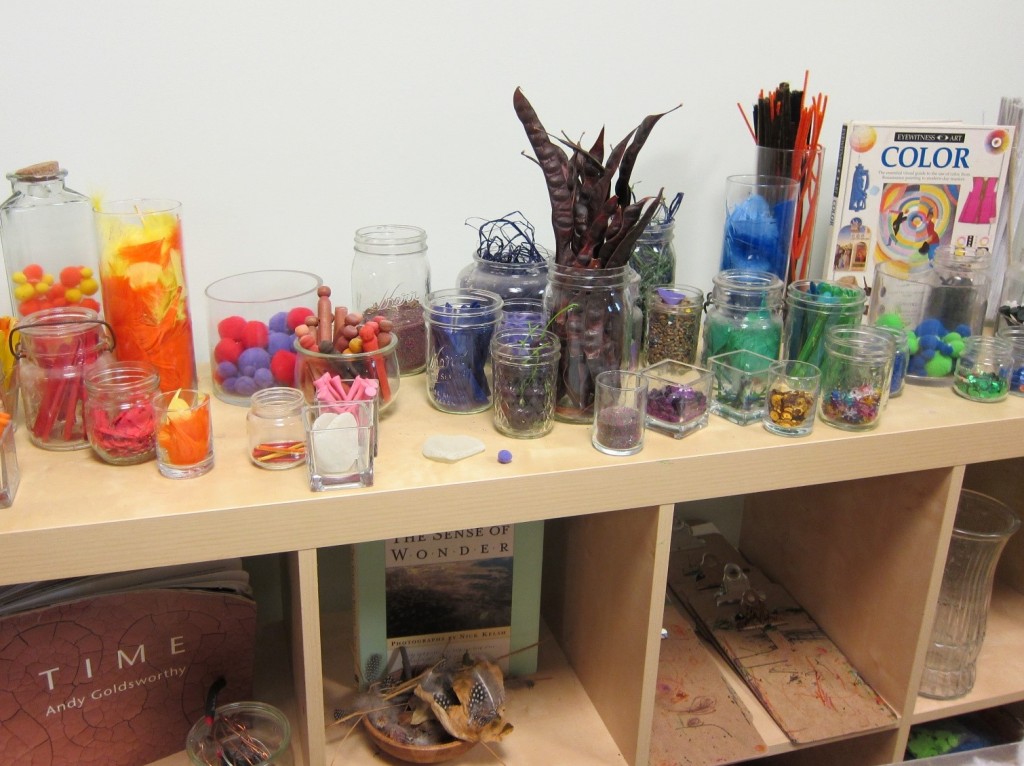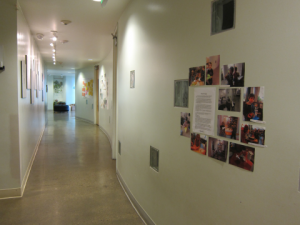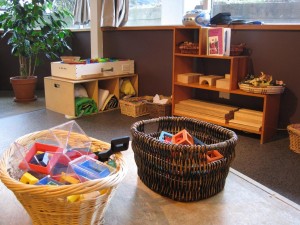
Environments for Reflective Practice
by Sarah Felstiner, Education Director, Hilltop Children’s Center
How does the design of our classrooms and schools impact our ability to be reflective and responsive as educators? Are there things we can do – through the layout of our space, and the materials we offer – to support our own intentions to approach children, and the curriculum, with an attitude of inquiry?
 Educators in the schools of Reggio Emilia, Italy suggest that when we plan the environment to promote discovery and engagement, it becomes another “teacher” in the classroom, another source of learning and possibility.
Educators in the schools of Reggio Emilia, Italy suggest that when we plan the environment to promote discovery and engagement, it becomes another “teacher” in the classroom, another source of learning and possibility.
Here at Hilltop, we’ve found that an intentionally designed and provisioned classroom helps us thoughtfully observe how children explore our invitations and provocations, and provides opportunities for us to gauge whether something is emerging that we want to help children pursue. Then, as parents and educators, we begin to see ourselves as researchers and collaborators with the children, and we naturally begin to shift how we spend our time with them.
Examples of Environmental Choices for Reflection
- Because we place a high value on learning in relationship, and co-construction of knowledge, we set up areas that invite large and small group work, rather than individual work. For example, open spaces that a whole class can meet, and cozy spaces that encourage several children to snuggle in together. We’re less likely to set up trays of materials for each child, and more likely to offer a selection of shared materials in the middle of a large table or platform.
- We keep fewer materials out on display, and rotate them regularly from our “materials library.” In addition to supporting a more aesthetically pleasing classroom, this intentional offering of materials helps educators gather information about children’s interests, and respond to their ideas by offering activities that build on their previous work.
- We provide open-ended drama materials, rather than “kitchen” furniture or a monthly theme-based rotation of drama props, because we are curious about what imaginative games children might want to play. We place flexible dramatic play materials (fabrics, stones, baskets, bowls) and large wooden blocks close to each other, so that children can construct the props and structures they need for their game.
- We tend to use baskets and other natural materials for display, rather than plastic bins.
- We set up materials on the floor, and on platforms of different heights, rather than emphasizing “seat work” at tables.
- We no longer label each bin, or the space on the shelf where it’s meant to go, for greater flexibility, and a more home-like feel.
- We display materials with an eye towards both aesthetic beauty and functional access for the children, presenting materials in a way that highlights or provokes particular possibilities.
- We vary sources and amount of lighting, using light to highlight certain areas, and invite specific kinds of play, and ensure that the space feel more like a home than a factory
Other Environmental Considerations
- Each classroom at Hilltop has a small art studio – a dedicated space for focused small group work and use of representational media. We also have a large “Community Studio” shared by all of our classrooms.
- We offer long stretches of time for uninterrupted play – often up to two hours – to promote deeper engagement. These long blocks of time allow children to spend time in many activities through the morning, or spend a satisfying time in just one activity. Meanwhile, educators have the time to observe and support children throughout the room.
- We prepare classrooms each day with”provocations” and “invitations to learning” for children to explore. These curated activities and materials might be new each day, or stay and develop over many days. They might be offered in direct response to play we’ve recently observed, or based on an educator’s curiosity about how the children will interact with a certain material.
Throughout the year we host Study Days where educators from around North America spend a day touring Hilltop’s environment, observing work in our classrooms and studios, and engaging in dialogue with Hilltop educators.
We are scheduling our Study Days for the next year now. Please contact us if you’d like to arrange a Study Day for educators at your program. The opportunity to connect with colleagues in this way, and hear their questions and ideas, brings yet another layer of Reflective Practice to our work at Hilltop.
[author] [author_image timthumb=’on’]https://hilltopcc.com/wp-content/uploads/2016/01/Sarah-Felstiner-photo-square.jpg[/author_image] [author_info]Sarah Felstiner is the Education Director at Hilltop Children’s Center, where she has worked since 1995.[/author_info] [/author]
1 thought on “Environments for Reflective Practice”
Comments are closed.

Thank you for your reflections, they inspire me to keep digging deeper on how to be intentional in each moment as we practice the Reggio way!